Long-Distance Freezing Design and Construction Based on Monitoring Analysis of Subway Connection Aisle
Abstract
:1. Introduction
2. Theoretical Background
2.1. Project Profile
2.2. Long-Distance Freezing Design of the Connection Aisle
2.2.1. Basic Principles of Freezing Reinforcement Design
- (1)
- The near-horizontal or inclined holes were used when drilling the freezing holes in the tunnel according to the structure of the connection aisle. Each drilling hole was equipped with an orifice pipe, and an orifice sealing device was installed to prevent the gushing of a large amount of mud during drilling. After each drilling, the volume of the outflow from the hole should be calculated in time, and the holes should be grouted immediately, combining with changes in monitoring data of the surface subsidence.
- (2)
- The thickness and strength of the frozen wall should meet the requirements of connection aisle excavation, especially the thickness of the frozen wall at the bell mouth, and in the meantime, the frozen wall should be completely bonded to the tunnel segments. The freezing and excavation should cooperate, and the excavation construction process should be adjusted in time based on the deformation of the frozen wall after excavation.
- (3)
- In order to reduce the influence of frost heave on subway tunnels, cold pipes and insulation layers were laid on the left and right tunnel segments near the bell mouth. The freezing speed was increased by reducing the distance between the freezing hole and the opposite tunnel segment and adopting a low brine temperature and large brine flow. In addition, the influence of soil frost heaves on tunnels was also reduced by laying out pressure relief holes in appropriate places.
- (4)
- The formation process and condition of the frozen wall were monitored through temperature measurement holes and pressure relief holes, especially the cementation condition between the frozen wall and opposite tunnel segments.
- (5)
- The grouting holes were embedded in the bottom plate, both sides, and top of the connection aisle, as well as the concrete of the pump house. The grouting holes were drilled in the tunnel segments for the convenience of grouting if necessary to prevent settlement and deformation of the ground tunnel and connection aisle. The temperature and settlement deformation of the frozen stratum and the deformation of the tunnel were monitored to guide the construction of the connection aisle.
- (6)
- A natural defrost method for thawing settlement grouting was used to control the differential settlement of soil and reduce the detrimental effects of freeze-thaw.
2.2.2. Key Points of Freezing Reinforcement Design
- (1)
- The design indexes of uniaxial compressive strength, bending strength, and shear strength of frozen soil (−10 °C) were 4.0 MPa, 1.8 MPa, and 1.5 MPa, respectively.
- (2)
- The frozen wall thickness was 2.2 m, among which the thickness of the bell mouth was 1.9 m, and the average temperature of the frozen wall was lower than −10 °C.
- (3)
- The freezing hole should be sealed after completion of the freezing construction, and the strength of the sealing concrete should not be lower than that of the segment.
- (4)
- At the openings of the connection aisle, the pre-stressed tunnel bracket should be laid out uniformly at the unopened part of the opening ring of the tunnel segment to reduce the adverse impact of the excavation construction on the connection aisle, and an emergency safety door should be installed above the tunnel portal on the excavation side.
2.2.3. Main Design Parameters for Freezing Reinforcement
2.2.4. Refrigeration System Design
- (1)
- The calculation of the heat absorption capacity of the frozen pipes and calandria [27] is performed using the following formula:where —total heat absorption capacity of the frozen pipes (kJ/h), A—total surface area of the freezer (m2), q—the heat absorption coefficient of the frozen pipes, which was 1047–1172 (kJ/m2h). In this project, = 3.65 × 104 kcal/h.
- (2)
- The calculation of the refrigeration capacity of frozen stations [27] is performed using the following formula:where Qz—refrigeration capacity of frozen station (kJ/h), m—cooling loss coefficient with a value of 1.1–2.
- (3)
- Brine circulation refrigeration system:
3. Research Study
3.1. Force Analysis of the Frozen Wall
3.2. Critical Technologies for Long Distance Freezing Construction of Connection Aisle
3.2.1. Construction of the Freezing Hole
3.2.2. Refrigeration Guarantee Methods
- (1)
- Heat dissipation at a frozen station
- (2)
- Heat insulation for brine pipes and segments
- (3)
- Brine flow and pressurization methods
3.2.3. Anti-Interference Methods in Cross-Construction
4. Results and Discussion
4.1. Monitoring Analysis of the Freezing Effect of the Long-Distance Stratum
4.1.1. Monitoring and Analysis of Brine Temperature
4.1.2. Monitoring and Analysis of Frozen Wall Temperature Measuring Hole
4.1.3. Monitoring and Analysis of Frozen Wall Pressure Relief Holes
4.2. Freezing Effect Analysis and Evaluation
4.3. Comparative Analysis of Various Freezing and Construction Methods
5. Conclusions
- (1)
- A freezing construction technology of long-distance low-temperature brine transportation for the synchronous construction of frozen stratum excavation of a subway connection aisle, shield tunneling, and track laying was developed. The design method and basis of the refrigeration system were determined, as were the technical points for long-distance freezing reinforcement construction and the detailed design and construction parameters. The proposed method can save time and has strong practical guidance for future subway connection channel construction.
- (2)
- The initial freezing period requires significant soil cooling, leading to a linear decrease in the brine temperature in the delivery and return pipelines. As the frozen wall develops gradually, the reduction in the heat load of the strata is less, resulting in a gradual stabilization of the brine temperature after around 27 days of freezing. The overall temperature difference of the brine between delivery and return pipelines also decreases gradually and stabilizes eventually over time.
- (3)
- The temperature at each measuring point of the frozen wall decreases linearly with time in the early stage and gradually tends to be stable in the later stage, and the average temperature reaches the designed temperature of −10 °C. It means that good freezing performance can be guaranteed by using insulation and pressurization equipment. The door-like scaffold and pre-stressed ring support can reduce the interplay of excavation of the connection aisle, tunnel excavation, and track laying.
- (4)
- By strategically placing pressure relief holes and managing the rate of pressure, the pressure within the frozen wall can be maintained below 0.5 MPa, preventing cracks and damage.
- (5)
- The average freezing curtain temperature is −13.9 °C, which accords with the Trupac theory of −9.7 °C and meets the design requirements of engineering.
- (6)
- It is essential in future studies to consider additional details, including hydrothermal phase change, the impact of salt content on freezing temperature, and the influence of soil thermal conductivity. Moreover, additional field test data are required to validate and enhance the design method, making it more suitable for diverse soil types.
Author Contributions
Funding
Institutional Review Board Statement
Informed Consent Statement
Data Availability Statement
Acknowledgments
Conflicts of Interest
References
- Wu, P.; Chen, Q.; Chen, Y.; Chen, S.; Zou, J. ISM-MICMAC based safety risk sources analysis and control measures for underground engineering of urban rail transit projects. J. Eng. Res. 2023, 153, 107550. [Google Scholar]
- Zhao, C.; Lei, M.; Shi, C.; Cao, H.; Yang, W.; Deng, E. Function mechanism and analytical method of a double layer pre-support system for tunnel underneath passing a large-scale underground pipe gallery in water-rich sandy strata: A case study. Tunn. Undergr. Space Technol. 2021, 115, 104041. [Google Scholar] [CrossRef]
- Shi, Z.; Xu, J.; Xie, X.; Zeng, H.; Xu, W.; Niu, G.; Xiao, Z. Disaster mechanism analysis for segments floating of large-diameter shield tunnel construction in the water-rich strata:A case study. Eng. Fail. Anal. 2024, 157, 107953. [Google Scholar] [CrossRef]
- Chen, R.; Cheng, G.; Li, S.; Guo, X.; Zhu, L. Development and prospect of research on application of artificial ground freezing. J. Geotech. Eng. 2000, 22, 40–44. [Google Scholar]
- Liu, X.; Shen, Y.; Zhang, Z.; Liu, Z.; Wang, B.; Tang, T.; Liu, C. Field measurement and numerical investigation of artificial ground freezing for the construction of a subway cross passage under groundwater flow. Transp. Geotech. 2022, 37, 100869. [Google Scholar]
- Mauro, A.; Normino, G.; Cavuoto, F.; Marotta, P.; Massarotti, N. Modeling Artificial Ground Freezing for Construction of Two Tunnels of a Metro Station in Napoli (Italy). Energies 2020, 13, 1272. [Google Scholar] [CrossRef]
- Tounsi, H.; Rouabhi, A.; Tijani, M.; Guérin, F. Thermo-Hydro-Mechanical Modeling of Artificial Ground Freezing: Application in Mining Engineering. Rock Mech. Rock Eng. 2019, 52, 3889–3907. [Google Scholar] [CrossRef]
- Chang, D.K.; Lacy, H.S. Artificial Ground Freezing in Geotechnical Engineering. In Proceedings of the Sixth International Conference on Case Histories in Geotechnical Engineering, Chicago, IL, USA, 11–16 August 2008; Volume 5. [Google Scholar]
- Zhou, X.M.; Jiang, G.; Li, F.; Gao, W.; Han, Y.; Wu, T.; Ma, W. Comprehensive Review of Artificial Ground Freezing Applications to Urban Tunnel and Underground Space Engineering in China in the Last 20 Years. J. Cold Reg. Eng. 2022, 36, 273. [Google Scholar]
- Fan, W.; Yang, P. Ground temperature characteristics during artificial freezing around a subway cross passage. Transp. Geotech. 2019, 20, 100250. [Google Scholar] [CrossRef]
- Powers, P.P.; Corwin, P.E. Ground Freezing. In Construction Dewatering and Groundwater Control: New Methods and Applications; John Wiley & Sons: Hoboken, NJ, USA, 2007. [Google Scholar]
- Li, J.; Li, J.; Cai, Y.; Wu, D.; Guo, C.; Zhao, W.; Tang, K.; Liu, Y. Application of Artificial Freezing Method in Deformation Control of Subway Tunnel. Adv. Mater. Sci. Eng. 2022, 2022, 3251318. [Google Scholar]
- Teng, J.; Dong, A.; Yan, H.; Tong, C.; Zhang, S. Predicting the hydraulic conductivity of frozen coarse-grained soils. J. Hydrol. 2023, 617, 129048. [Google Scholar] [CrossRef]
- Zhang, K.; Guo, A.; Yu, Y.; Yang, B.; Yu, B.; Xie, C. Freeze–thaw damage degradation model and life prediction of air-entrained concrete in multi-year permafrost zone. Materials 2023, 16, 7703. [Google Scholar] [CrossRef]
- Golewski, G.L. The effect of the addition of coal fly ash (CFA) on the control of water movement within the structure of the concrete. Materials 2023, 16, 5218. [Google Scholar] [PubMed]
- Fu, Y.; Hu, J.; Wu, Y. Finite element study on temperature field of subway connection aisle construction via artificial ground freezing method. Cold Reg. Sci. Technol. 2021, 189, 103327. [Google Scholar] [CrossRef]
- Song, H.; Cai, H.; Yao, Z.; Rong, C.; Wang, X. Finite Element Analysis on 3D Freezing Temperature Field in Metro Cross Passage Construction. Procedia Eng. 2016, 165, 528–539. [Google Scholar] [CrossRef]
- Zhang, S.; Zhou, X.M.; Ma, W.; Liu, Y.; Lu, C. Longitudinal temperature acquisition system of ground freezing and its application in solving temperature field. Cold Reg. Sci. Technol. 2023, 213, 103911. [Google Scholar] [CrossRef]
- Hong, Z.; Hu, X. Application of Analytical Solution to Steady-State Temperature Field by Double-Row-Pipe Freezing and Verification with Field Measurement: A Case Study of Connected Aisle. Adv. Civ. Eng. 2019, 2019, 6435060. [Google Scholar] [CrossRef]
- Chen, J.; Zhang, Y.; Chen, B.; Zhao, Z.; Wang, Q. Development characteristics of freezing temperature field of coastal soft soil strata. Coal Geol. Explor. 2020, 48, 25. [Google Scholar]
- Hu, J.; Liu, Y.; Li, Y.; Yao, K. Artificial Ground Freezing In Tunnelling Through Aquifer Soil Layers:a Case Study in Nanjing Metro Line 2. KSCE J. Civ. Eng. 2018, 22, 4136–4142. [Google Scholar] [CrossRef]
- Yan, Q.; Xu, Y.; Yang, W.; Geng, P. Nonlinear Transient Analysis of Temperature Fields in an AGF Project used for a Cross-Passage Tunnel in the Suzhou Metro. KSCE J. Civ. Eng. 2018, 22, 1473–1483. [Google Scholar] [CrossRef]
- Hu, J.; Li, K.; Wu, Y.; Zeng, D.; Wang, Z. Optimization of the Cooling Scheme of Artificial Ground Freezing Based on Finite Element Analysis: A Case Study. Appl. Sci. 2022, 12, 8618. [Google Scholar] [CrossRef]
- Zhang, M.; Wan, H.; Yang, Y. Construction technology of the freezing method for the connecting-passage in the subway. In IOP Conference Series: International Conference on Oil & Gas Engineering and Geological Sciences, Dalian, China, 28–29 September 2019; IOP Publishing: Bristol, UK, 2019; Volume 384, p. 012090. [Google Scholar]
- Zhuang, Y.; Chen, J.; Zhang, J.; Wang, J.; Li, H. Analysis of the Development Characteristics and Influencing Factors of Freezing Temperature Field in the Cross Passage. Adv. Civ. Eng. 2021, 2021, 6645139. [Google Scholar] [CrossRef]
- Zhang, Y. Field Monitoring and Numerical Simulation of Subway Connection Tunnel Excavation Based on Freezing Method. Master’s Thesis, Taiyuan University of Technology, Taiyuan, China, 2022. (In Chinese). [Google Scholar]
- DB11/T 1972-2022; Technical Standard for Freezing Method Construction of Urban Rail Transit Engineering. China Architecture Publishing & Media Co., Ltd.: Beijing, China, 2022; pp. 10–11.
- Tрупак, Н.Г. Замoраживание Гoрных Пoрoд при Прoхoдкествoлoв; Углетехиздат: Moscow, Russia, 1954. (In Russian) [Google Scholar]
- Бахoлдин, Б.В. Выбoр Оптимальнoгo Режима Замoраживания Грунтoв в Стрoительных Целях; Гoсстрoйиздат: Moscow, Russia, 1963; pp. 21–27. (In Russian) [Google Scholar]
- Chen, K.; Dai, Z.; Zhang, H.; Wang, Y. Analysis of construction monitoring and temperature field of cross-passage of subway in seashore area in Xiamen using ground freezing method. J. Eng. Geol. 2023, 31, 1748–1756. (In Chinese) [Google Scholar]
- Chen, J.; Guo, Q.; Zhou, H.; Kui, W.; Dong, X. Construction scheme and application analysis of synchronous construction of subway shield tunnels and freezing reinforcement for cross passages. Mod. Tunn. Technol. 2023, 60, 233–241+248. (In Chinese) [Google Scholar]
- Yang, Z. Study on design optimization of long distance cold transportation and freezing system for bulk volume freezing project. Mine Constr. Technol. 2022, 43, 65–70. (In Chinese) [Google Scholar]
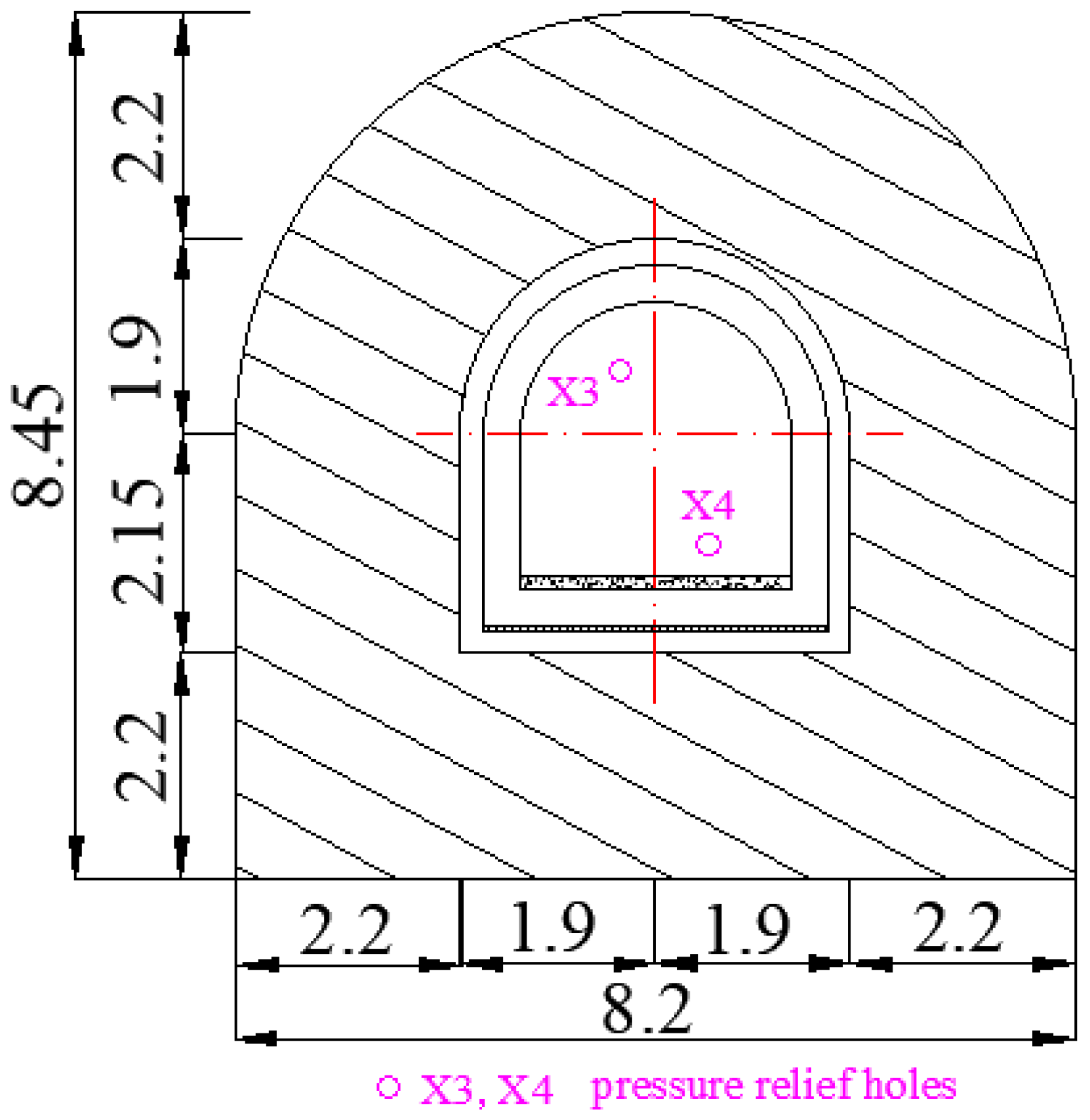

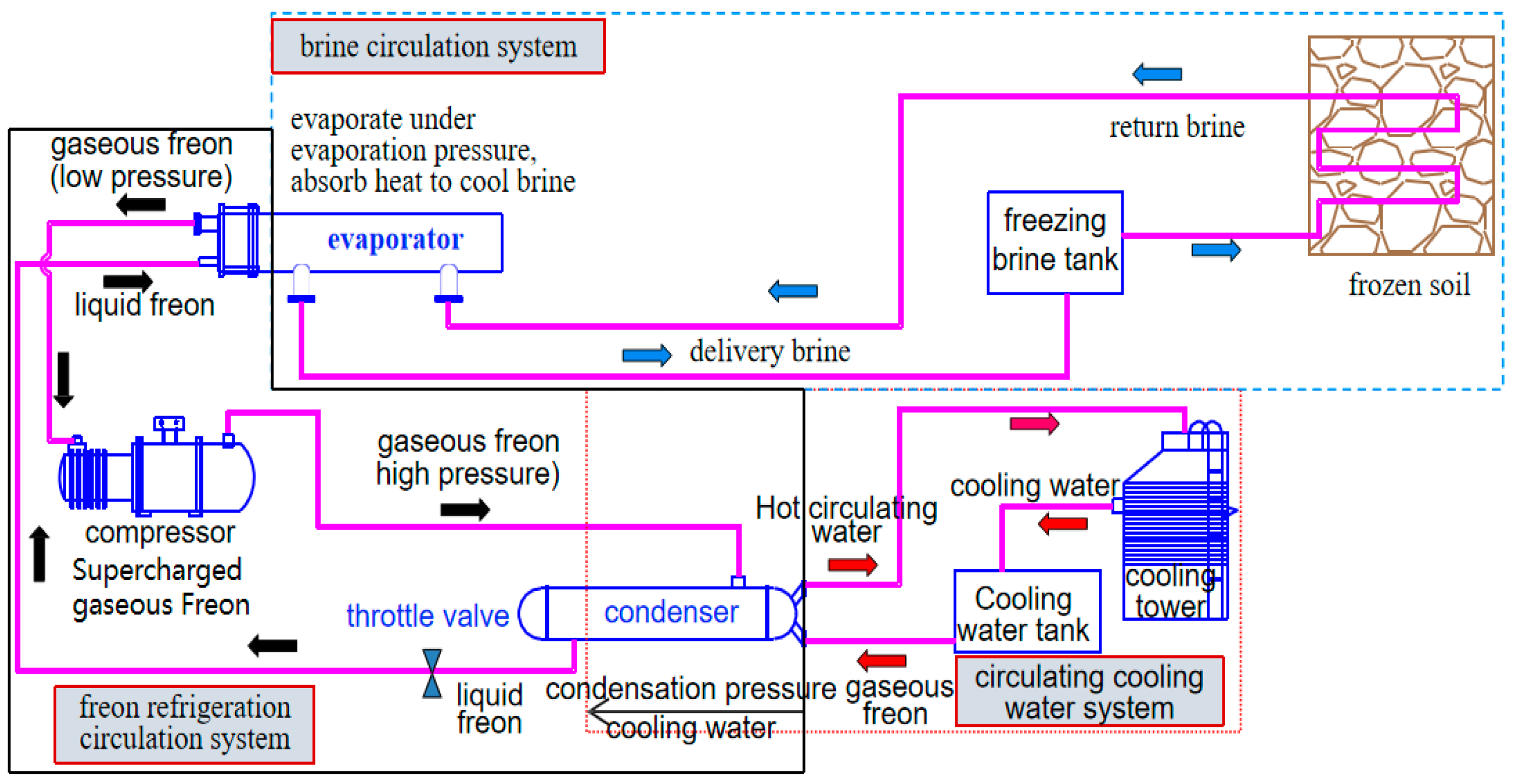
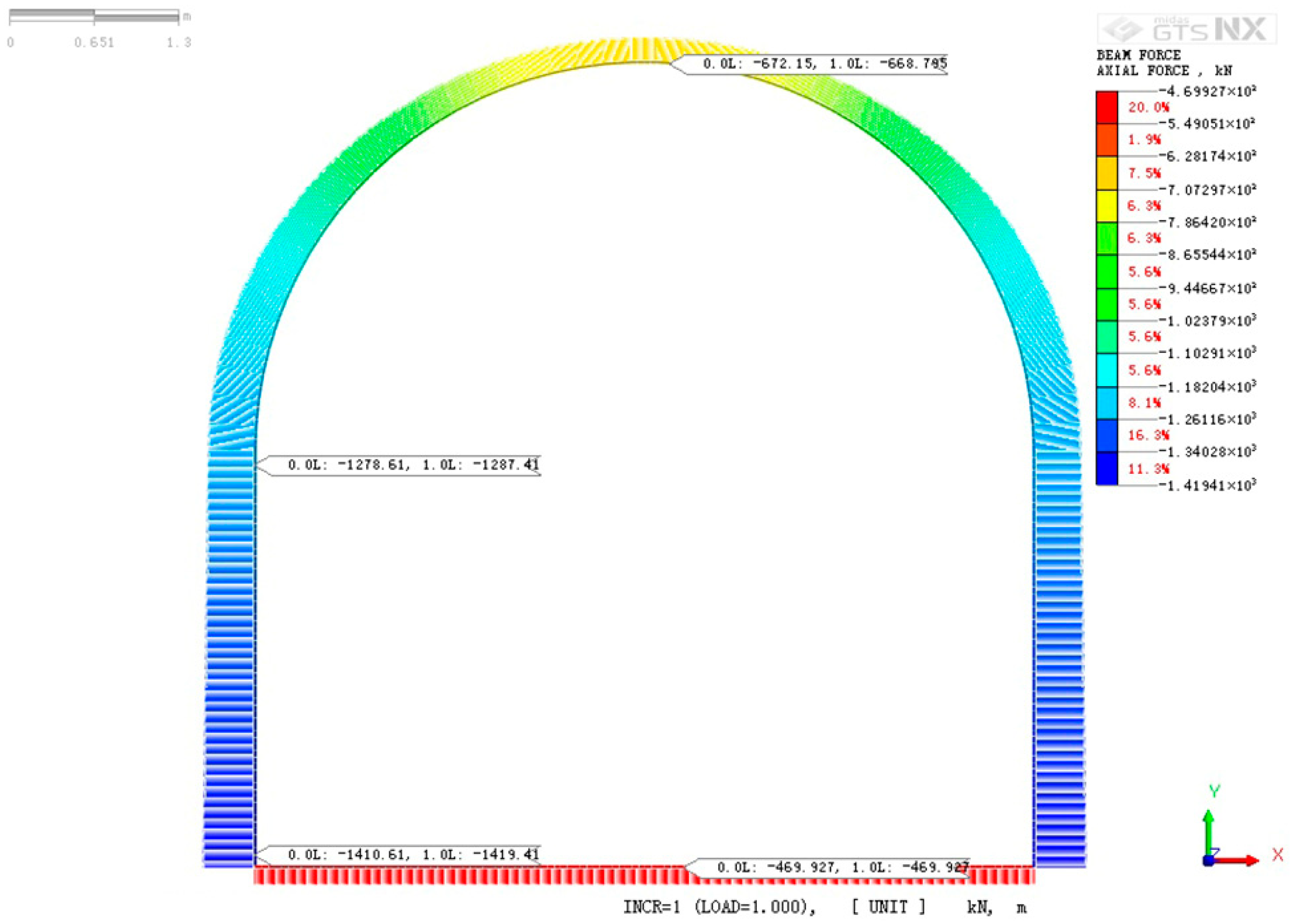
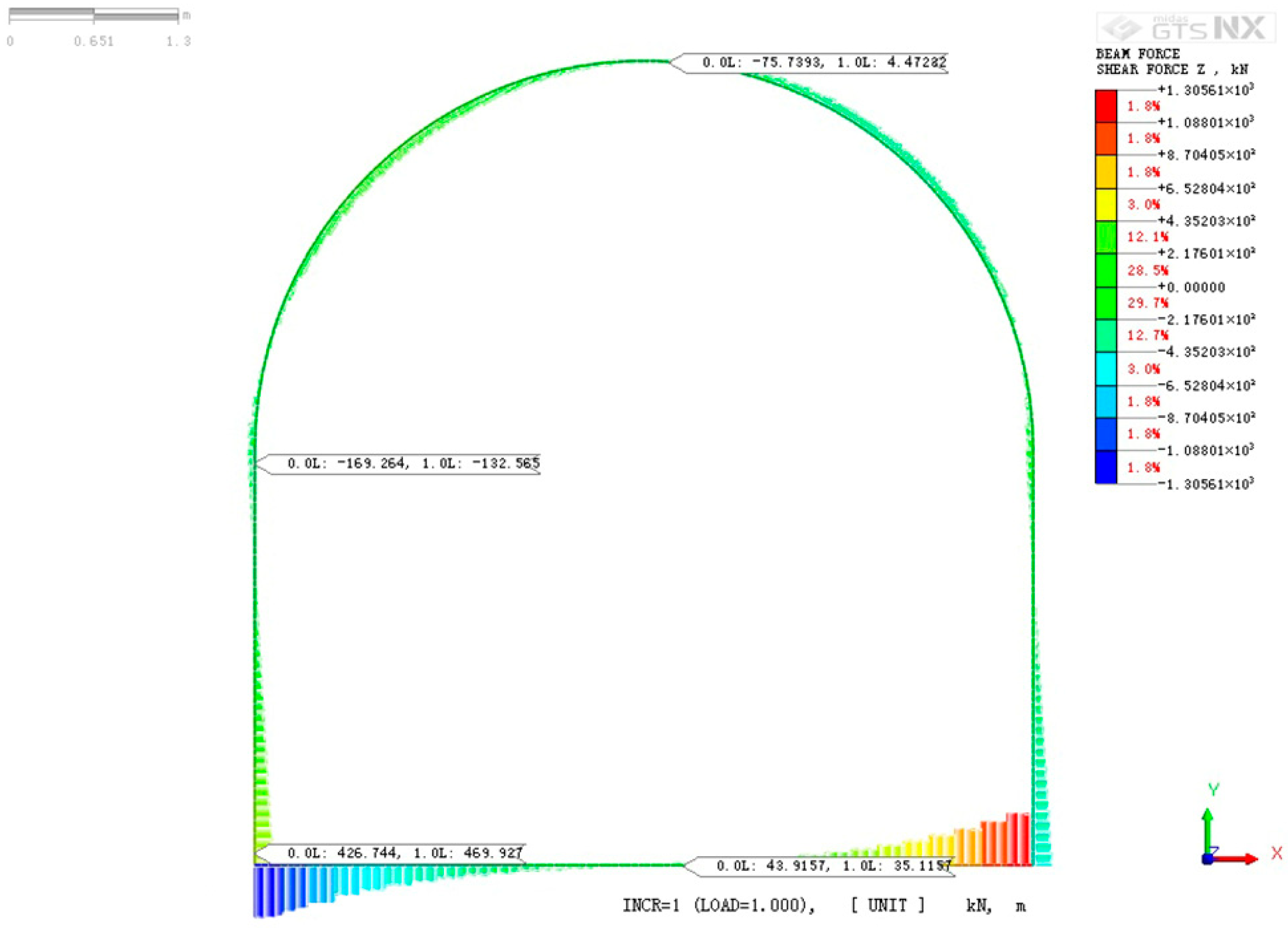
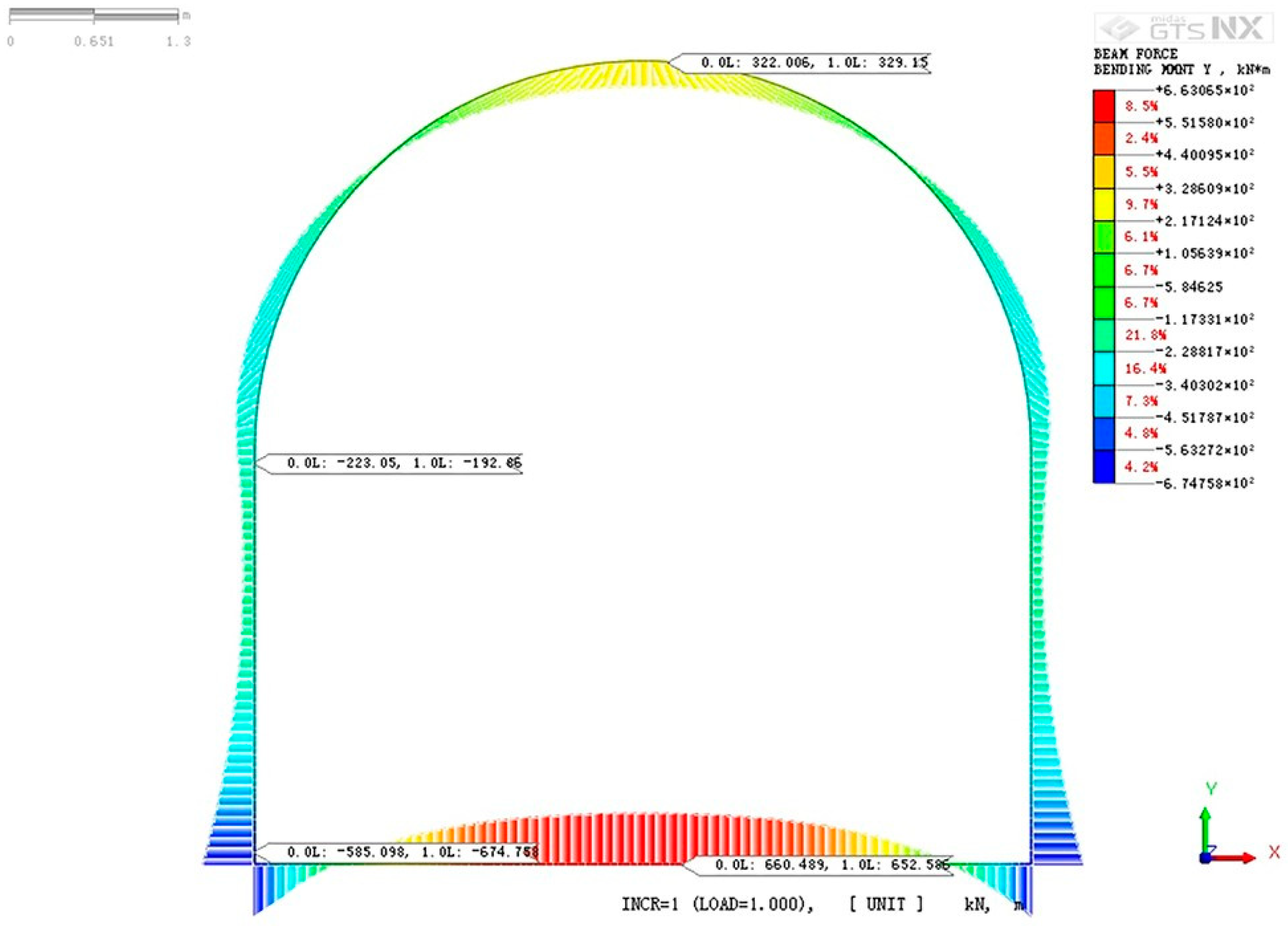
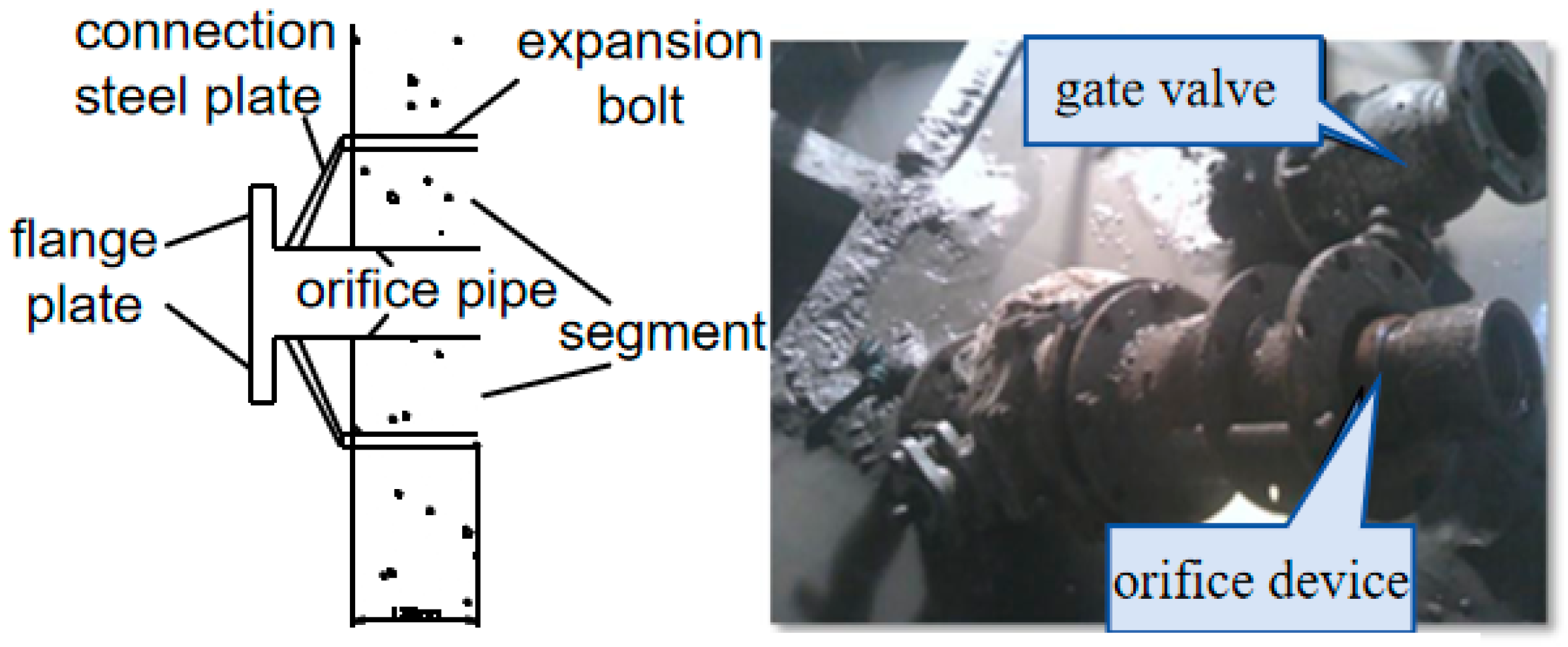
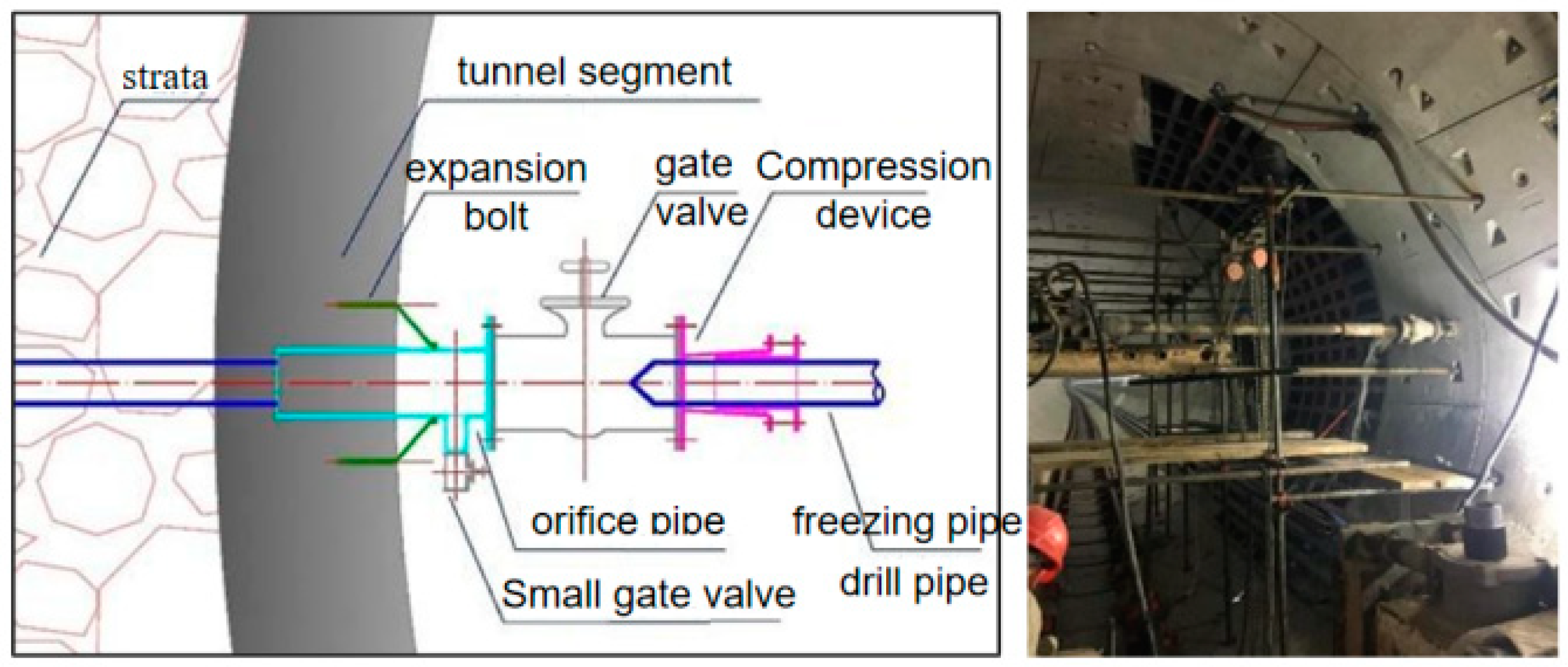

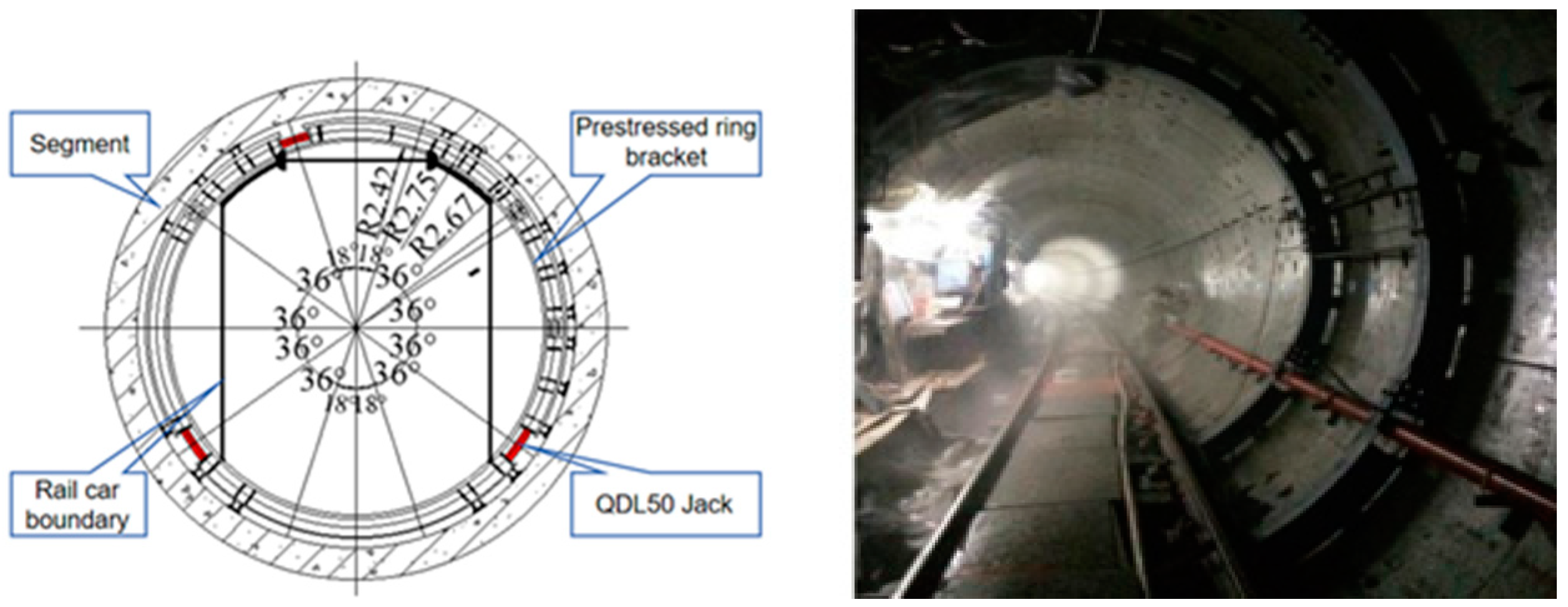

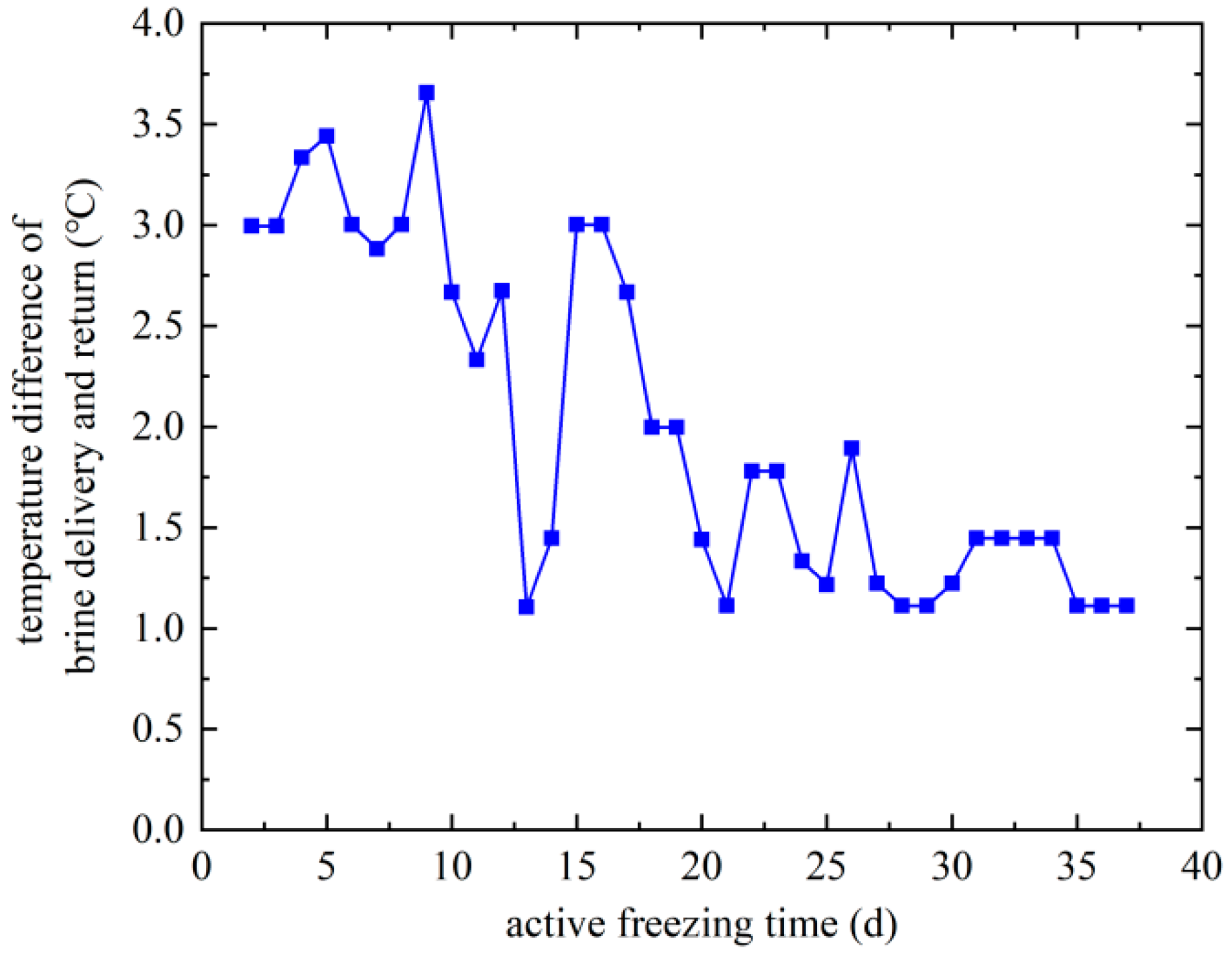
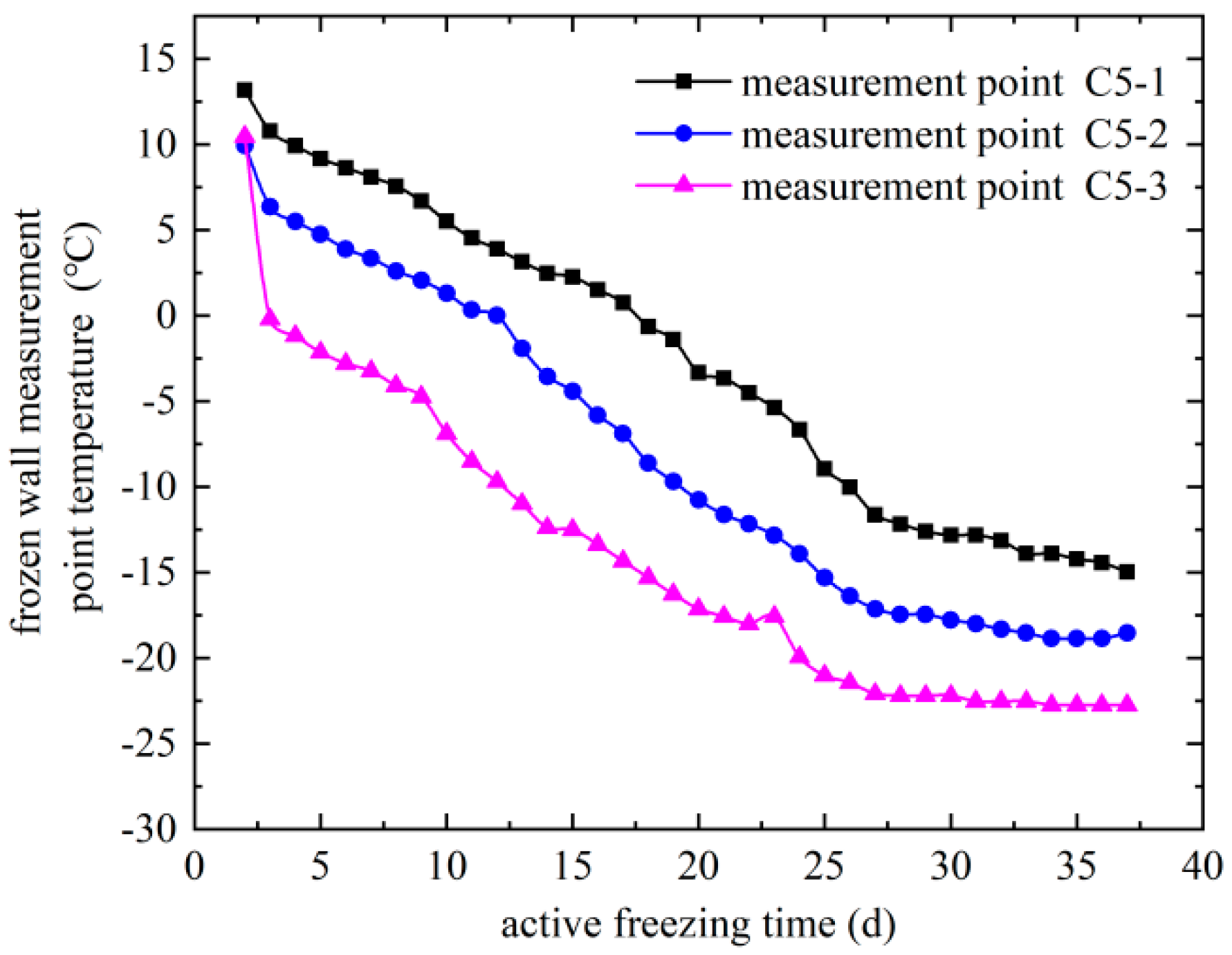


| Engineering Name | Main Research Content |
|---|---|
| Nanning Subway Line No. 3 [16] | Investigating the development and spatial distribution of the temperature field during artificial freezing using three-dimensional finite element methods |
| Shanghai Metro Line No. 13 [17] | Modeling yields a detailed distribution pattern for freezing temperature fields |
| Guangzhou Metro [18] | Developed a longitudinal temperature acquisition system to address the inaccuracies in the determination of temperature fields |
| Maliuzhou Tunnel [19] | Exploring the optimal freezing scheme of double-circle freezing methods |
| Between Luoxiu Road Station and Baise Road Station of Shanghai Subway Line No.15 [20] | Analyzing the thickness and average temperature of frozen curtains and the freezing process |
| Between Xinjiekou Station and Shanghai Road Station of Nanjing Metro Line No. 2 [21] | Application of artificial ground freezing in tunnels through aquifer soil layers |
| Donggang West Road of Lanzhou Metro Line No. 1 [12] | Application of the freezing method for reinforcement and monitoring in the dangerous situation of mud and water inrush |
| Suzhou Metro [22] | Examining the evolutionary process of the freezing curtain |
| No. 2 connection aisle between the Gongzhongfu Station and the Inner Mongolia Stadium Station of Hohhot Metro Line 2 [23] | Evaluating the influence of different brine cooling schemes on the freezing process |
| Harbin Rail Transit Line 2 Dagengjia Station to Longchuan Road Station [24] | Introduces the construction scheme of the freezing method and analyzes the safety of the construction with the monitoring data |
| Parameter Name | Unit | Design Value |
|---|---|---|
| Uniaxial compressive strength of frozen soil | MPa | 4 |
| Flexural strength of frozen soil | MPa | 1.8 |
| Shear strength of frozen soil | MPa | 1.5 |
| Frozen wall thickness | m | 2.2 |
| Average temperature of the frozen wall | °C | ≤−10 |
| Active freezing time | d | ≥55 |
| Maximum spacing between freezing holes | mm | 1500 |
| Freezing hole allowable deviations | mm | ≤150 |
| Minimum brine temperature | °C | −28 |
| Single-hole brine flow | m3/h | 5~7 |
| Freeze pipe specifications | mm | Φ89 × 8 Φ108 × 8 |
| Temperature measurement hole specifications | mm | Φ32 × 3.5 |
| Pressure relief hole specifications | mm | Φ32 × 3.5 |
| Section Position | Internal Force Values | ||
|---|---|---|---|
| Axial Force (kN) | Shear Force (kN) | Bending Moment (kN·m) | |
| Corner of the wall | 1419 | 470 | 675 |
| Bottom plate | 470 | 44 | 660 |
| Project | Calculated Value/MPa | Strength Index/MPa | Safety Coefficient | |
|---|---|---|---|---|
| Compressive/bending stress | б1 | 0.43 | 1.80 | 4.23 |
| б3 | 1.69 | 4.00 | 2.36 | |
| Shearing stress | тmax | 0.37 | 1.50 | 4.03 |
| Strata Freezing Temperature/°C | Frozen Wall Thickness/M | Average Temperature of Frozen Wall/°C |
|---|---|---|
| 0 | 2.2 | −6.4 |
| −0.7 | 2.2 | −6.9 |
| −3.9 | 2.2 | −9.7 |
Disclaimer/Publisher’s Note: The statements, opinions and data contained in all publications are solely those of the individual author(s) and contributor(s) and not of MDPI and/or the editor(s). MDPI and/or the editor(s) disclaim responsibility for any injury to people or property resulting from any ideas, methods, instructions or products referred to in the content. |
© 2024 by the authors. Licensee MDPI, Basel, Switzerland. This article is an open access article distributed under the terms and conditions of the Creative Commons Attribution (CC BY) license (https://creativecommons.org/licenses/by/4.0/).
Share and Cite
Xu, Y.; Liu, Q.; Zhi, W.; Shao, G.; Liu, P. Long-Distance Freezing Design and Construction Based on Monitoring Analysis of Subway Connection Aisle. Coatings 2024, 14, 355. https://doi.org/10.3390/coatings14030355
Xu Y, Liu Q, Zhi W, Shao G, Liu P. Long-Distance Freezing Design and Construction Based on Monitoring Analysis of Subway Connection Aisle. Coatings. 2024; 14(3):355. https://doi.org/10.3390/coatings14030355
Chicago/Turabian StyleXu, Yin, Qiang Liu, Weiting Zhi, Guangqiang Shao, and Peng Liu. 2024. "Long-Distance Freezing Design and Construction Based on Monitoring Analysis of Subway Connection Aisle" Coatings 14, no. 3: 355. https://doi.org/10.3390/coatings14030355






